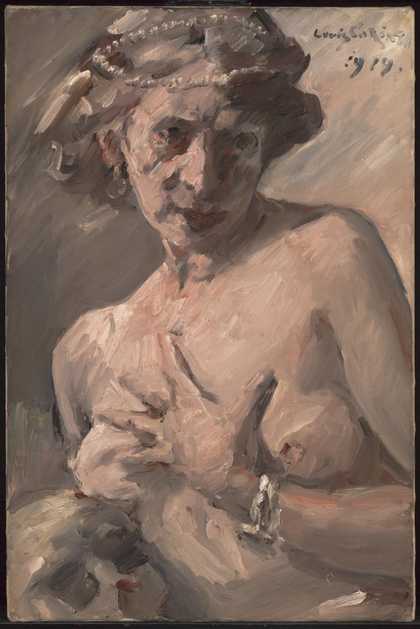
Lovis Corinth
The Temptation of St Anthony after Gustave Flaubert (1908)
Tate
Lovis Corinth holds a unique position in the realm of German art of his age; he belongs both to the nineteenth and twentieth centuries. His early works are perfect examples of the pictorial style of the nineteenth century. His late works, as regards his use of colour, hover on the threshold of contemporary art.
Despite the widely divergent contrasts which characterise the work of Corinth, his artistic development shows an impressive steadiness and consequence. The individual stages of it might well be described as Tone Painting, Pleinairism, Impressionism and Expressionism. But these terms give but little idea of Corinth’s art: he never really belonged to any of these schools or movements.
From 1884 to 1887 Corinth studied in Paris. It is significant to know what inspired him most was not the French Impressionists but Leibl’s painting of The Poachers. He admired its ‘furor teutonicus’, because it incorporated his own personal ambition.
Corinth’s early works comprise to a very great extent portraits and nudes. The portraits of his father are particularly outstanding; every stroke, every line and feature in the portrayal of this warm-hearted, thoughtful old man revealed the respect and sincerity felt for him by his son. These pictures have almost an oldmasterly quality; there is no suspicion of theatrical pose (so popular with the fashionable painters of the time) or of a virtuosity born of routine.
The portraits of his friends, painted during his early years, always succeed in capturing the individual character of the subject, depicting him as a physical and spiritual whole. The nudes often give the impression of being somewhat academic, though Corinth’s knowledge of the structure of the human body and the way in which he paints the skin, with gentle, almost fondling, brushstrokes, testify to supreme skill and the finest sensitivity.
Along with Liebermann and Slevogt he became one of the leader of German Impressionism and in 1915 succeeded the former as President of the ‘Berlin Secession’ in which he had been prominent since 1899.
The abundance of his life is interrelated with the development of his style. His palette becomes richer, brighter, more colourful.
In 1911 the painter had a severe stroke. Slowly, painfully, step by step, Corinth developed the style of his last years. The first self-portrait after his illness (1912) signals the approach of this final period, where his works take on a frenzied quality and the surface of his paintings is torn and lacerated.
In spite of the violent process of deformation, however, Corinth remains firmly attached to the visible world.

